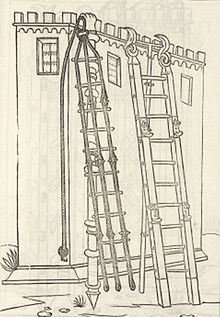Scaling ladder

A scaling ladder ( Latin : scalae (impetus faciendi causa paratae) ; French : échelle pour monter a l'assaut ) is a ladder with one or two spars
- to storm a defensive structure (e.g. city wall ), or
- as an aid in fire fighting by the fire brigade or in disaster relief. The ladder is part of the standard equipment of the fire brigade and is carried on fire trucks . ( See also: hook ladder ), or
- the rope ladder, which is attached to the stern of a ship in order to be able to transfer to a boat.
A scaling ladder has a limited length (nowadays usually one storey height ), has hooks at the top and can accommodate several people.
The scaling ladder for military purposes could be broken down into small units. The sturdy wooden versions of scaling ladders were connected to one another in order to achieve the appropriate length (e.g. for the city wall) and had large hooks ( storm hooks ) at the top to firmly anchor the scaling ladder.
The flexible scaling ladder was a rope ladder with crossbars (rungs).
Escalating (escalade, French: escalader, escalade - to climb) means to climb using a scaling ladder.
The scaling ladder as a weapon of war
The scaling ladder was an important medieval weapon of war. It was easy and easy to use. The task of the storm columns was to climb the ramparts of the castle or fortress or the city wall on scaling ladders, to try to establish themselves there and to open the gate from the inside to clear the way for those who followed.
The scaling ladder as a fire fighting device

The fire brigade's climbing ladder (hook ladder) is 4.40 m long and has a hook on the top with which it can be hung in a higher opening. Since they z. B. can be hung on every balcony or in every window, its working height as the only ladder is practically unlimited.
It is rarely used, for example when other types of conductors are not suitable. Hook ladders with steel hooks (68 cm) weigh 11 kg, ladders with light metal hooks (70 cm) weigh around 9 kg. The hook has 11 teeth so that the ladder cannot slip off after hanging. The tip of the hook is bent downwards. Two deflectors on the lower side of the ladder ensure that there is sufficient distance to the wall or wall. The stiles of the hook ladder used to be made of pine, larch, spruce or ash wood, the rungs, which were reinforced with additional rung anchors and wedged and glued into the stiles, were made of ash wood. A galvanized steel wire on the inside of the stiles ensured that the ladder remained usable even in the event of stile damage. Nowadays, hook ladders made of aluminum with a titanium-reinforced steel hook are common.
The hook ladder is usually carried out by two people, but only ever climbed by one person (both troop people climb one after the other from floor to floor). In addition to using a ladder in an emergency, it is also used in fire fighting competitions in the hook ladder discipline .
Historical illustrations
Two rope ladders on fol. 28r in Konrad Kyeser's Bellifortis manuscript Ms. Thott. 290.2º from 1459
Two scaling ladders on fol. 27v in Konrad Kyeser's Bellifortis manuscript Ms. Thott. 290.2º from 1459
See also
Individual evidence
- ^ Joachim Heinrich Campe in "Dictionary of the German Language", Volume 4, Braunschweig 1810.
- ↑ previously also written as "Sturmhacken".
- ^ Scaling ladder. In: Johann Heinrich Zedler : Large complete universal lexicon of all sciences and arts . Volume 40, Leipzig 1744, column 1435.
- ↑ Explanation of the Duden - German universal dictionary
- ↑ Thomas Zawadke: Die Roten Hefte, Booklet 204 - portable ladders . 2nd Edition. Kohlhammer, Stuttgart 2016, ISBN 978-3-17-023272-3 .


